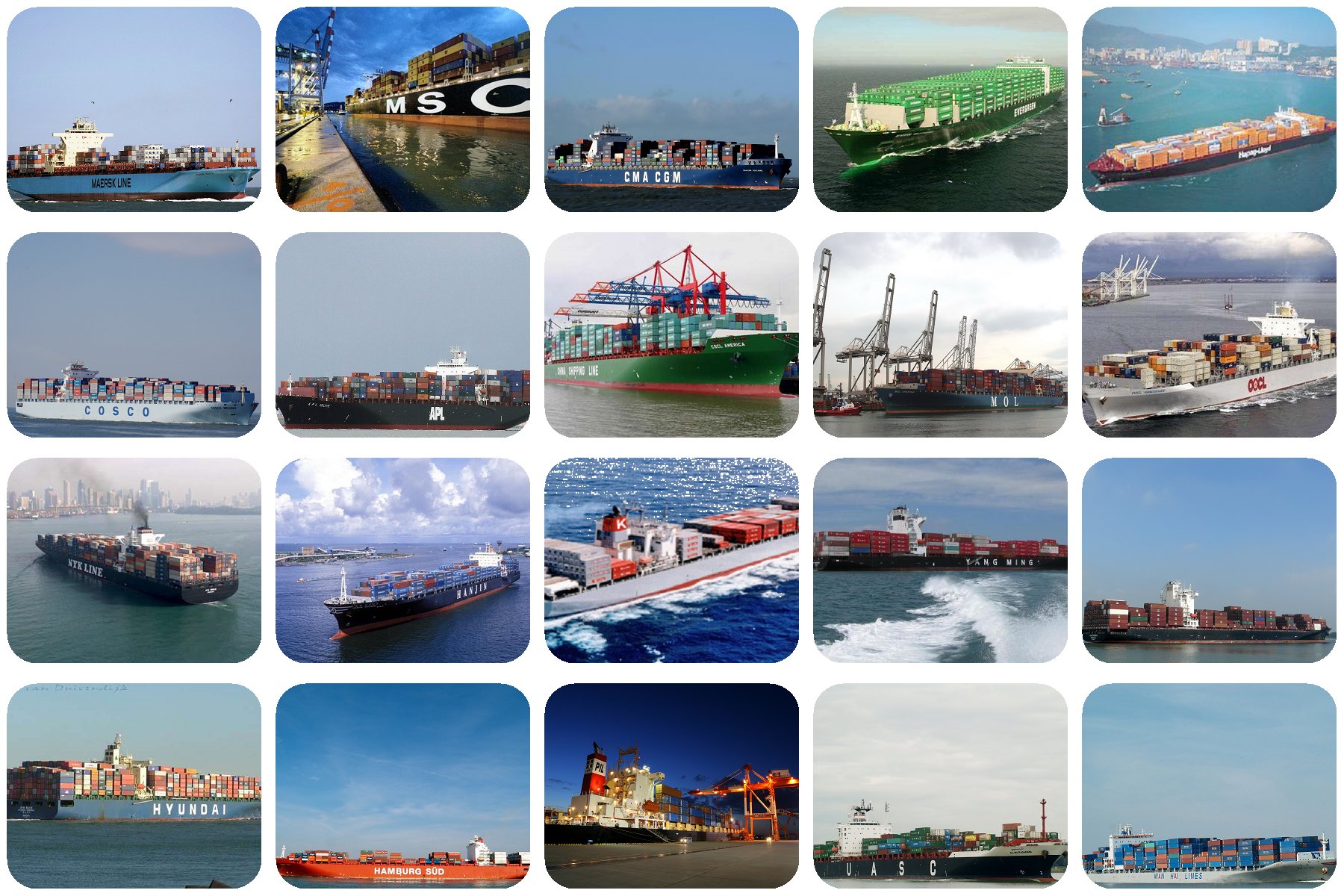Global liner shipping industry 2016 first half performance reviews

- Date: Oct 08, 2016
- Comments: 1
- Categories: News
As the anticipated capacity growth will continue to outstrip transport demand, the difficult times for the liner industry will continue for some years to come.
Nest overthrown, how there will be intact eggs?
To March next year on the line of the three major member companies, 3M three (Maersk, Mediterranean Shipping, Hyundai), Ocean Alliance four (CMA, COSCO Shipping, Evergreen, Orient Overseas), THE Union 6 + 1 Hapag-Lloyds + Arabian ships to be merged, Yangming, Hanjin, Mitsui, Nippon Yusen, Kawasaki Steamboat). Plus the non-aligned hamburger South America and the stars, a total of 16 home. Which in addition to the need to publish the results of the Mediterranean Shipping and CMA CGM two family businesses and private enterprises in Hamburg, South America, the remaining 13 major liner companies 2016 first half of the annual report has been announced. From the published data, this year the whole industry will be a loss of 50 100 billion US dollars of the “curse” does not seem nonsense.
According to reports, Wan Hai “miserable victory” in the first half net profit of 9.5 million US dollars, compared to last year’s 101 million US dollars plummeted 90.6%.
In addition, the other 12 companies in the first half “storied dye”, a red. To the calendar year transcripts of the most beautiful of several “honors” for:
● Maersk shipping losses of $ 114 million, compared with net income of $ 12.21 million, down 109.3%;
● CMA CGM reported a loss of US $ 228 million, compared with a net profit of US $ 561 million for the same period last year and a decrease of 140.6%.
● OOCL lost $ 57 million, compared with net income of $ 239 million for the same period last year, which was down 123.8%.
● Hapag-Lloyd loss of $ 158.4 million, compared with $ 175.2 million net profit last year, results fell 190.4%;
● Evergreen lost $ 194 million, more than last year’s full-year loss ($ 117 million).
In addition, there is no suspense, COSCO Shipping, Yangming Shipping and Arab ship all three state-owned losses. Of which China COSCO (601,919) attributable to shareholders of listed companies in the first half net profit of -72.09 billion yuan (about 1.08 billion US dollars), down 465.2% year on year. Yang Ming loss of $ 283 million, more than last year’s loss ($ 197 million).
Because the merger with the Hapag-Lloyd and was forced to announce results of the Arab ship reported a loss of $ 201 million in the first half, while the full-year 2015 loss of $ 384 million. As a result of this performance recovery, the Arabian shipping fleet, together with CSCL (a loss of $ 383 million), bottomed out at a loss of $ 384 million for all major liner companies by 2015.
Another state-owned US presidential ship, as the end of last year to fly acquisition, so from the first half of this year do not have to publish results. Temasek’s reluctance to continue selling family property and “blood transfusion” to maintain “face” after the loss of US $ 1.36 billion in the US President’s ship in 2009-2015, while choosing to return a little “lair” for US $ 2.5 billion.
Invisible hand press the pause button, the ship tide change “stream”
Caused by the current plight of the shipping industry is the main reason for the downturn in tariffs, and freight rates stumble endlessly because of supply and demand imbalance.
From the demand side, consumption and investment are two basic factors driving the development of the container shipping industry. However, the lack of economic growth in many major economies constrains consumer demand; at the same time, global economic uncertainty has dampened government and business investment enthusiasm. From this it is not difficult to understand why the growth in cargo volume is so low.
From the capacity supply side, Maersk wrongly estimated the situation, take the lead in custom-made ship. According to the Lloyd’s List, “the most influential shipping industry in 2015, 100 people,” ranked first is An Shi Nian, Shi Suoren and Fei Yifan Maersk Group of the trio, praised them in the shipping industry The prospects bleak to enhance the company’s performance. At the same time, the reasons for the recommendation point out that “willingness to admit that mistakes are rare, Maersk Group executives acknowledged their misconceptions about the prospects for container trade growth in 2015. The unexpected sharp drop in freight demand and the volume of trade between Asia and Europe The drop in real terms is a wake-up call for the entire shipping world. ”
By 2015, the herd effect is fully launched, the global new container ship-made tide surge, especially in the third quarter, the new order as a single snowflake. Moreover, the new orders are significantly tilted towards the large vessels, the capacity of more than 16,000 TEU orders for the ship has exceeded the total capacity of new orders in 2014 the total capacity, so as to achieve a new level. Last year, 94 percent of new shipments exceeded the permissible limits for the Panama Canal Old Ship Lock; 27 percent of the total ship capacity exceeded 16,000 TEUs.
Weak demand and low tariffs have failed to prevent the advent of new ships. In 2015, a total of 212 new ships shipped, the total capacity of nearly 1.7 million TEUs, accounting for the total fleet capacity of 8%. As a result, the average capacity of new vessels amounted to 7900 TEU, 8% increase over 2014.
But from the fourth quarter, “invisible hand” press the “pause” button. New ship orders were down cliff-type. By the end of July this year, new ship orders to the total TEU, for the active fleet of the total capacity of 17%, since 1999, the lowest proportion. According to Alphaliner, by the end of 2016 this proportion will fall to 14%.
According to Drewry, although there are still sporadic orders for new ships this year, no new ship orders of more than 8,000 TEUs were delivered throughout the second quarter. According to the standard box, the current order of 86% of the total capacity of ships is 3500 TEUs and the following capacity of the boat. Reported that the second half of this year’s new ship orders will not be higher than the first half.
This year’s new orders include a large number of ships below 4000 standard containers, most of which are used within the Asian region routes, such as Taiwan Wanhai Dingzha 8 2500 TEU, China’s domestic trade custom tailored 20 2500 mark Box and below.
According to Alphaliner, as of August 1, the world’s largest 100 liner companies had a fleet capacity of 19.4 million TEUs, but the new ship order capacity was just over 3 million TEUs. After deducting the scrap capacity, the global fleet capacity in 2016 is expected to grow 3.6% over the previous year, the same record low. The biggest problem is that the growth rate of transport demand is lower, so the situation of excess capacity supply in the near future will continue.
Despite the market downturn, but last year, according to the plan should ship the ship, or 86% of the ship scheduled ship. Only 3% of the order capacity was canceled, 11% was delayed factory. In the first quarter of 2016, there were 240,000 TEUs shipped.
“Considering that there is already a lot of capacity left unused and the growth of traffic on certain routes is stagnant, the new capacity that needs to be deployed as more ships are shipped,” said Dong Jiancheng, Chairman of OOIL, the parent company of OOCL. Continue to grow, the second half of the liner industry, the day will be very difficult.
Despite the overall decline in new ship orders, there is a big difference in the volume of orders between companies and companies. COSCO Shipping, Evergreen, Nippon Yusen and Pacific Shipping have 35% to 40% of the order capacity and in-service capacity (including their own vessels and charters). But Hanjin, Hyundai and the three companies is to star zero orders.
Westerly withered Bishu last night, blowing off numerous orders
The fourth quarter of last year, due to market fundamentals deteriorated, coupled with MARPOL Convention on the emission of nitrogen dioxide standard window of the right to shut down the number of new ship orders significantly reduced. Article 13 of Annex VI to the MARPOL Convention provides that ships operating on or after January 1, 2016, which do not meet emission standards, may not engage in trade operations in the North American and US Caribbean Emissions Control Areas (ECAs), with more stringent emission standards .
A good factor in improving capacity supply and demand is that most of the orders for new ships this year are concentrated below 3500 TEUs. Drewry’s report that the second half of this year’s new ship orders will not be higher than the first half.
According to Drewry’s report predicts that this year’s global fleet capacity increased by about 3.2% over last year. The report finds that a significant reduction in new ship orders is good news, because the capacity of ships in service has far exceeded demand.
Another positive factor is the increase in shipbreaking capacity. The charter rate was so low that many shipowners would prefer to ship some of the younger ships to the ship-breaking plant, including many old Panamax vessels of capacity between 4500 and 5100 TEU. Recently, even some 15-year-old 6,500 TEUs have been disassembled. In 2015, a total of 194,000 TEUs of capacity were sent to shipbreaking yards, and 456,000 TEUs are expected to be disassembled in 2016. Many ship-breaking yards are even predicting that this year’s 500,000 TEU capacity will need to be disassembled.
With the Panama Canal the third set of locks in operation, on the original Panamax ship’s future fate in the end how the problem has been in the industry caused widespread controversy.
However, if the liner company this year, can get a little breathing space, then the situation next year is difficult to say, because the 2015 tide custom orders placed in the next year there will be a large number of ships will be shipped.
Drewry’s report points out that 2017 will still be tough, as carriers will have to work hard to properly place a large number of new shipments, but also to ship those ships that have been replaced. Although the growth rate of container transport demand may reach 1.8 percent in 2017, more than 1 percent in 2016, liner companies will not be able to absorb these additional capacity simply by the growth in trade volume. As the capacity growth and idle ships have been at a high level, so 2016 and 2017 balance of supply and demand capacity will further deteriorate. Nonetheless, the availability of ships on the forward route was 86% to 87%. But this is not a normal phenomenon, because in recent months, tariffs on certain routes have fallen to unreasonably low levels.
However, the storage capacity can sometimes magically pulled up tariffs. For example, tariffs have risen after the removal of 30% of capacity on the Asian-South American East Coast route. In contrast, in the European – Brazil route, because there is no abatement capacity, tariffs continue to show a downward trend.
However, due to the 2015 tide of the orders placed in the period, next year there will be a large number of ships will be shipped. As the anticipated capacity growth will continue to outstrip transport demand, the difficult times for the liner industry will continue for some years to come.
Although the growth rate of container transport demand may reach 1.8 percent in 2017, more than 1 percent in 2016, liner companies will not be able to absorb these increases only by the growth in trade volume. As the capacity growth and idle ships have been at a high level, so 2016 and 2017 balance of supply and demand capacity will further deteriorate.
Philip Demas, supply chain consultant at Drewry Shipping Consulting, said: “The level of tariffs over the past year is not sustainable. He warned the shipper to be wary of a rebound in freight rates, and the contract price would go up. However, Daimas also noted that the liner transport industry, excess capacity situation will affect the rate of increase in tariff rates and amplitude. He said that tariffs can not be twice, three times up, but only a small increase. According to Drury’s “Insight Insight Weekly” report released in late July, carriers are storing more capacity. In early July, this should be the start of the season when the season, the supply of more than 300 idle ships, storage capacity of more than 800,000 TEUs. In the past two years in July, idle capacity is not more than a quarter of this figure. According to the report, part of the newly created idle ship may be disassembled, especially those old old Panama type ship.
Industry consolidation case in general is conducive to the entire shipping industry
Over the past year, the liner industry has experienced several industry consolidation cases: the merger of COSCO and China Shipping, the acquisition of US President Vessel Steamship steamships, and the ongoing merger of Hapag-Lloyd and Arabian shipping companies.
Hapag-Lloyd’s chief executive, Rolf Hepburn Jensen, says industry acquisitions can reorient the balance between shippers and carriers to the overall benefit of the shipping industry in general.
The world’s largest container ship owner Seaspan (Seaspan) Chief Executive Officer Wang Yougui agree with Johnson’s view. He believes that mergers and acquisitions will make the industry environment more harmonious and harmonious. From the Hapag-Lloyd and Arabian ship consolidation cases, the combined capacity of the two companies is very small, accounting for 5.8% and 5.5% of their in-service capacity respectively. However, the merger between the two companies can be postponed very effectively Hapag-Lloyd’s investment demand for new ships.
In the world’s major liner companies, Hapag-Lloyd’s lack of large ships is a significant feature. The second half of this year to the first half of next year, Hapag-Lloyd is scheduled to ship a new ship only 10 13,000 TEU and 5 10500 TEU.
On the other hand, since 2014, the capacity of the Arab ship has doubled, the new ship orders, including in the high cost of custom-made when the 17 very large ship. The company already has six 18,800 TEUs, and by the end of the year there will be 11 15,500 TEUs.
However, since the second half of 2014, the Arab ship company’s debt increased by 1.8 billion. As of the end of June this year, the company’s total debt of up to 4 billion US dollars, while the company’s total assets of only 1.9 billion US dollars. Obviously, in this context, the Arab ships can only accept very low prices into Hapag-Lloyd.
Jensen said that the two companies after the merger, the entire fleet of the average age of 6.6 years, is the industry’s youngest fleet. Seventy-seven percent of the company’s fleets are less than 10 years old. Of the combined fleet capacity, 62 per cent were owned vessels and the remainder were chartered vessels.
“In the next few years, we do not have to invest heavily in new vessels,” Jensen said. “We can ensure that our fleet is at its best, and we can adjust our capacity as needed.”
Alphaliner’s report that within 2016, the large liner companies are unlikely to occur between the new M & A activities. The combination of Hapag-Lloyd’s and the Arabian ships has become a reality, mainly because of the deep sense of the shareholders, who have never paid dividends since 2009 but are willing to continue to invest.
Some of the controlling shareholders of the two companies have agreed to increase the total additional investment of $ 400 million within six months of the completion of the merger transaction. These include South American Steamship (CSAV), Kühne Maritime, Hamburg City Holding, Qatar-controlled companies and a Saudi Arabian public investment fund. After the merger of the company, the total capacity will reach 1.6 million TEU, ranking fifth in the world, annual revenue may reach 12 billion US dollars.
It is estimated that new acquisitions will not be possible between large liner companies by 2016.
The alliance between the large ship competition and the prospect of large-scale ship
The current four-ship-sharing (VSA) shipping alliance will be re-divided into three major alliances starting next spring. Dirk Weiss, a senior shipping consultant at Dynamar Shipping Consultancy, calculated the total capacity of the three alliances, including active and under construction, based on data as of the end of July.
Ocean Union will have 195 (140 in service, 46 under construction), 2.71 million TEU capacity of the very large container ships. These include 93 new Panamax vessels (13,500-14,000 TEUs), 60 new Panamax vessels (below 18,000 TEUs) and 42 vessels of more than 18,000 TEUs.
2M alliance with modern merchant ship will have 186 (125 in service, 70 under construction), 2.78 million TEUs of large container ships. Including 86 “new Panamax” ships, 49 “new super Panamax” ships, and 51 ships of more than 18,000 TEUs.
The Alliance will have 142 (89 in service, 53 under construction), 1.94 million TEUs of VLCCs, including 55 New Panamax vessels, 77 New Super Panamax vessels, As well as 10 ships of more than 18,000 TEUs.
It can be seen that the size of each Union ship composition is different, each company has its own independent development strategy. However, due to the uncertainty of economic growth, forecasting becomes more and more difficult. Part of the reason is that Europe and the United States near-shore procurement, 3D printing and robot posts and other trends, making the future economic growth will not be as fast as the beginning of this century.
“The impulse to invest in the construction of VLCCs is based on the expectation of a global location for the manufacturing sector,” said the report, “however, Consumer preferences are gradually changing.We expect the future development trend of transport demand will not repeat the pattern of the past few decades with the arrival of the fourth wave of industrial revolution, the manufacturing sector will become more and more regional, Transport distance will become shorter and shorter.In addition, due to the application of new technologies, a new generation of consumers are changing consumption patterns, intercontinental long-distance transport has become increasingly unnecessary.It seems that the world is in transition, Redefining the container shipping industry.Although today’s traditional trade will continue to exist, but we expect the future of intraregional trade will become increasingly important, while the east-west trade routes to the importance of the main trade is increasingly weakened.Thus, Some shipowners with less mobility may be less suited to the needs of future customers, but liner companies will still have a stronger voice than shipbuilders with chartered vessels. ”
The size of the ULCS will continue to expand, but the pace of development will slow down over the past decade, the DNV GL says.
Some changes to the ship’s parameters will help to reduce the fuel consumption per unit TEU, for example, by increasing the breadth of the vessel to 24, or increasing the length of the ship from the original 24-row container to 26-row to 23,300 TEU .
DNV GL said: “If at the same time to increase the width of the ship to 25, the captain increased to 26 rows, then the ship capacity can be increased to 26,300 TEU.But there are many ports can not accept the standard of the ship, and can not be loaded The Suez Canal requires a completely new design concept, and it is unlikely that such a ship will appear in the foreseeable future.







1 Comment
That’s not just the best ansrwe. It’s the bestest answer!